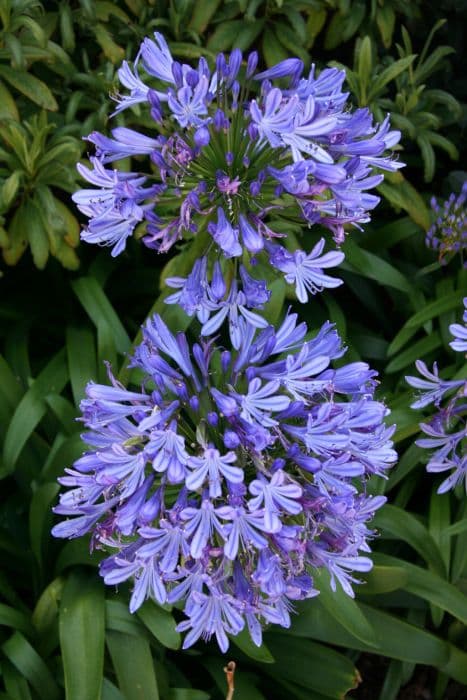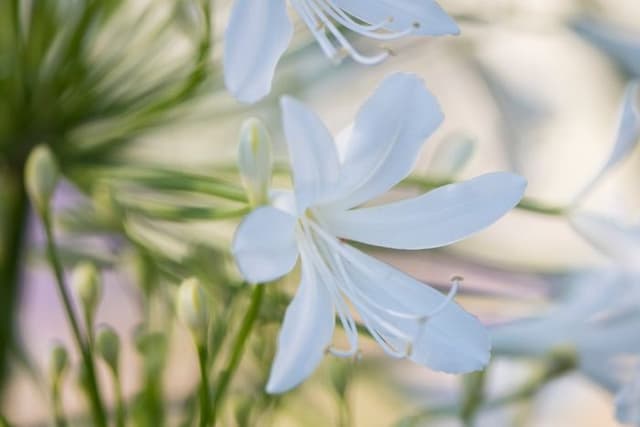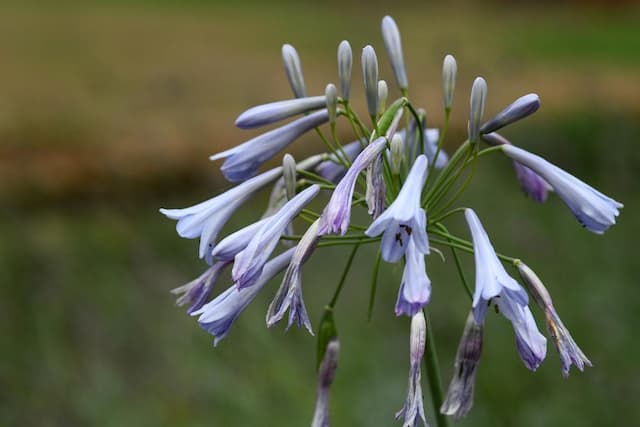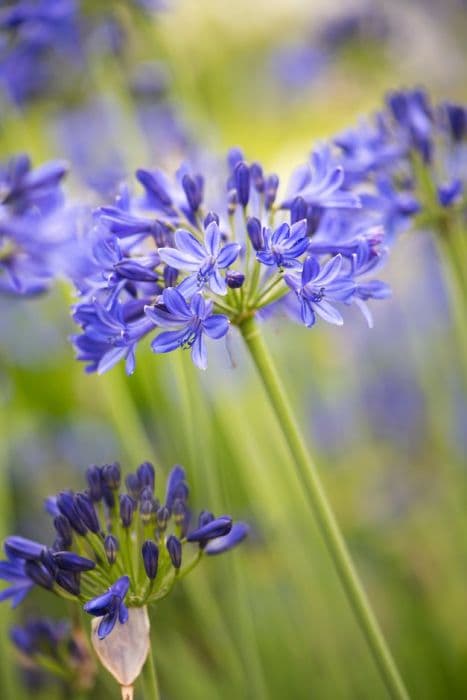African Lily Agapanthus 'Moonlight Star'

ABOUT
The Agapanthus 'Moonlight Star', also known as the Lily of the Nile, is easily identifiable by its striking features. The plant boasts lush, strap-like foliage that creates a dense and verdant backdrop for the true showstoppers: its flowers. The blooms appear on tall, upright stems and are composed of clusters of individual florets. The florets are typically a beautiful blend of subtle colors, primarily showcasing shades of blue, violet, or white, and often have a contrasting stripe down the center of each petal, giving a star-like effect that likely inspired the name 'Moonlight Star'. The flowering heads resemble round, globe-like umbels that add an ornamental, almost sculptural quality to the plant. These graceful flower heads provide a whimsical and airy feel, creating a sense of movement as they sway gently in the breeze. The overall impression of the Agapanthus 'Moonlight Star' is one of elegant simplicity and natural charm, making it a beloved feature in gardens where its serene beauty can be fully appreciated.
About this plant
 Names
NamesFamily
Amaryllidaceae
Synonyms
African Lily, Lily of the Nile, Love Flower
Common names
Agapanthus 'Moonlight Star'
 Toxicity
ToxicityTo humans
The Agapanthus, also known as Lily of the Nile or African Lily, can be toxic if ingested. It contains substances that are potentially harmful, such as saponins and glycosides. If parts of the plant are eaten, it may lead to symptoms such as nausea, vomiting, abdominal pain, and diarrhea. In severe cases, ingesting large quantities could potentially result in more serious consequences like tremors or cardiac arrhythmia, though such extreme reactions are rare. It is recommended to seek medical attention if ingestion occurs and symptoms manifest.
To pets
The Agapanthus, also referred to as Lily of the Nile or African Lily, is toxic to pets. This plant contains compounds such as saponins that can cause gastrointestinal upset in animals if ingested. Symptoms of poisoning in pets may include vomiting, diarrhea, drooling, lethargy, or abdominal pain. In some cases, particularly if large amounts are consumed, more severe symptoms could occur, which might require prompt veterinary attention to prevent more serious health issues.
 Characteristics
CharacteristicsLife cycle
Perennials
Foliage type
Evergreen
Color of leaves
Green
Flower color
Blue
Height
2 feet [60 cm]
Spread
2 feet [60 cm]
Plant type
Bulb
Hardiness zones
8
Native area
South Africa
Benefits
 General Benefits
General Benefits- Ornamental Appeal: Features striking blue to white flowers which add visual interest to garden landscapes.
- Attracts Wildlife: Blossoms can attract pollinators such as bees and butterflies, enhancing biodiversity.
- Low Maintenance: Requires minimal care once established, which is ideal for busy gardeners.
- Drought Tolerance: Able to survive periods of low rainfall, making it suitable for xeriscaping.
- Long Blooming Season: Provides flowers through summer into fall, offering lasting color in the garden.
- Adaptable: Can thrive in a variety of soil types, as long as they are well-draining.
- Border and Container Gardening: Versatile for use in garden borders or as a container plant for patios.
- Cutting Garden Plant: Excellent for cut flower arrangements due to its long stems and showy blooms.
- Perennial Growth: As a perennial, it will come back year after year, offering long-term presence in the garden.
- Erosion Control: The root system can help stabilize soil and prevent erosion on slopes.
 Medical Properties
Medical PropertiesThis plant is not used for medical purposes.
 Air-purifying Qualities
Air-purifying QualitiesThis plant is not specifically known for air purifying qualities.
 Other Uses
Other Uses- The Agapanthus can be used as a natural dye; the flowers and leaves may produce colors ranging from green to blue when used in fabric dyeing processes.
- Agapanthus blossoms can be used in floral art; their striking blue flowers add an exotic touch to arrangements and installations.
- As an edible flower, Agapanthus petals can subtly garnish desserts and salads, though they should be used sparingly due to their mild toxicity.
- The slim, strap-like leaves can be woven into small crafts or used in basketry as a decorative element.
- Agapanthus plants can be grown as a living fence or border because of their clumping growth habit, effectively creating a visual barrier in gardens.
- The spent flower stems can be repurposed into natural supports for other climbing plants within the garden.
- The dried seed heads of Agapanthus can be used in dried flower arrangements or as unique additions to wreaths and other dry crafts.
- Agapanthus can serve as an educational tool in botany and horticulture studies, illustrating monocot characteristics and breeding practices for ornamental horticulture.
- The species' resistance to deer and other herbivores allows its use in areas where other ornamental plants might suffer from grazing.
- Given their coastal origins, Agapanthus can be used in coastal gardens as they are capable of withstanding salt sprays and sandy soils.
Interesting Facts
 Feng Shui
Feng ShuiThe African Lily is not used in Feng Shui practice.
 Zodiac Sign Compitability
Zodiac Sign CompitabilityThe African Lily is not used in astrology practice.
 Plant Symbolism
Plant Symbolism- Love Letters: The name Agapanthus comes from the Greek words 'agape' meaning love, and 'anthos' meaning flower, symbolizing love letters or messages.
- Beauty: The striking blooms of the Agapanthus 'Moonlight Star' are often associated with beauty and admiration, which is why they're frequently used in gardens and floral arrangements to captivate onlookers.
- Fertility: In some cultures, the abundant flowers of the Agapanthus plant symbolize fertility and the creation of new life.
- Endurance: Given the plant's ability to thrive in harsh conditions, it's often seen as a symbol of endurance and surviving through difficult times.
- Freedom: The free-flowing nature of the plant's foliage and flowers may represent freedom and lack of restraint.
 Water
WaterThe Agapanthus, commonly known as Lily of the Nile, should be watered thoroughly and allowed to dry out between waterings. In warmer climates, this usually means watering once a week with about one to two gallons of water, depending on the size of the plant and the weather conditions. During peak summer heat, watering frequency may increase. However, during the winter months, or in cooler climates, water less frequently, monitoring the soil moisture to prevent overwatering. Always avoid letting the plant sit in standing water as it can induce root rot.
 Light
LightLily of the Nile thrives best in full sun to partial shade. Ideally, this plant should receive at least six hours of sunlight per day. The perfect spot for Lily of the Nile would be where it can bask in the morning sunlight while being protected from the harsh afternoon sun, particularly in hotter climates.
 Temperature
TemperatureLily of the Nile prefers temperate conditions and can endure short periods of cold, but not below 25 degrees Fahrenheit. Ideally, they flourish in temperatures ranging from 60 to 75 degrees Fahrenheit. They can survive a maximum temperature well above 80 degrees Fahrenheit as long as they are appropriately watered.
 Pruning
PruningPruning Lily of the Nile should be done to remove spent flower stalks and to tidy up any dead leaves. This will encourage new growth and more blooms the following season. Pruning is best done after flowering, usually in the late fall or early winter. Regular deadheading during the blooming season can also promote a longer flowering period.
 Cleaning
CleaningAs needed
 Soil
SoilThe best soil mix for the African Lily, or Agapanthus 'Moonlight Star', is well-draining soil with a mix of loam, peat, and sharp sand or perlite. This plant prefers a soil pH between 6.0 and 7.0 for optimal growth.
 Repotting
RepottingAfrican Lily should be repotted every 2 to 4 years, or when it becomes root-bound. Repotting is typically done in the spring before the growing season starts.
 Humidity & Misting
Humidity & MistingAfrican Lily thrives in moderate to high humidity levels but is quite adaptable and can tolerate less humid conditions commonly found in homes.
 Suitable locations
Suitable locationsIndoor
Place in bright light, water moderately, ensure good air circulation.
Outdoor
Plant in sunny spot, shelter from strong winds, well-drained soil.
Hardiness zone
8-11 USDA
 Life cycle
Life cycleAgapanthus 'Moonlight Star', commonly known as Lily of the Nile, begins its life cycle as a seed, which germinates in warm, well-draining soil with plenty of light. After sprouting, the young seedlings develop into juvenile plants with strap-like leaves, slowly forming a clumping base. As the plant matures, it establishes a strong root system and increases its foliage mass in preparation for flowering. The mature Lily of the Nile produces long, sturdy stalks topped with clusters of star-shaped flowers, typically during the summer months. After blooming, the flowers develop into seed pods that eventually dry and release seeds, allowing for the cycle to begin anew. Once established, the plant may also propagate vegetatively by division, thus skipping the seed stage and producing genetically identical offspring.
 Propogation
PropogationPropogation time
Late spring to early summer
Propogation: The Agapanthus 'Moonlight Star', commonly known as Lily of the Nile, is often propagated by division, which is most successfully done in the spring after the plant has emerged from dormancy but before it has put on a lot of new growth. To propagate by division, carefully lift the clump of the plant from the ground using a spade or fork. Gently tease apart the roots to separate individual clumps, ensuring each division has a number of healthy roots and at least one or two growing points or shoots. Replant these divisions immediately at the same depth they were originally growing and water them thoroughly. This method of propagation not only helps in multiplying your plants but also invigorates older clumps that may have become too dense, often resulting in better flowering.









